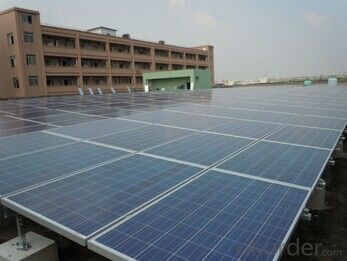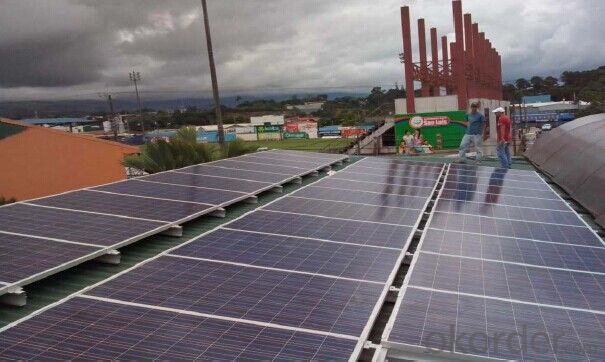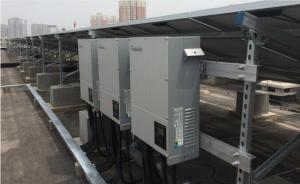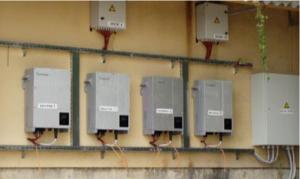Solar Power Inverter 1000W-3000W Grid Tie Solar Inverter
- Loading Port:
- Shekou
- Payment Terms:
- TT or LC
- Min Order Qty:
- 10 pc
- Supply Capability:
- 100000 pc/month
OKorder Service Pledge
OKorder Financial Service
You Might Also Like
Solar power inverter 1000W-3000W grid tie solar inverter
Specifications
Maximum efficiency 97.8%, wide input voltage range
Internal DC switch
Transformerless GT topology
Compact design
1500 2000 3000 4400 5000TL
General Descriptions
Leading-Edge Technology, CE,TUV ,VDE , SAA,DK5940 Certicificates.
> Maximum efficiency of 97.8 % and wide input voltage range
> Internal DC STWTICH
> Transformerless H6 topology
> Compact Design
> MPPT control
> MTL-String
> RS485 RS432 bluetooth Technology
> Comprehensive Growatt warranty program
> Easy country configuration, easy installation
> Multi-language display
Communications
> RS485 /GPRS interfaces
> Computer monitoring software
Safety
> Full protection functions:DC reverse polarity, AC short-circuit protection, ground fault monitoring, grid monitoring, integrate all-pole sensitive, leakage current monitoring unit.
> Standards complied: EN61000-6-1, EN61000-6-2, EN61000-6-3, EN61000-6-4,EN61000-3-2, EN50178, VDE0126-1-1,IEC-62109
FAQ
1. Have any design tool and how to use it?
Shine Design is the system design software just for inverters, It can conduct installers to figure out panel numbers for a system, panel numbers for each string, and which inverter model is suitable for the system. Moreover, it can print a design report after input all necessary parameters, can calculate DC/AC wire wastage, annual generation, etc.
2. Does the inverter have monitoring solutions for residential system?
For small rating system, we have wired two monitoring solution (ShineNet via RS232 or RS485). (a) Local wireless monitoring solution (ShineVision via RF module communication) (b) Global wireless monitoring solution (WIFI module via WIFI network)
3. Do you have free solution for monitoring?
ShineNet is an inverter monitoring software run in Windows XP, Windows Vista, Windows 7 operating system. It can monitor inverter via RS232 (or RS232 convert to USB cable) and RS485 wire connection. Customers can purchase the cable locally to get the inverter monitored, it is simple.



Technical Specifications
Model Specifications | 1500 | 2000 | 3000 | 4000 | 4400 | 5000 |
Input data(DC) | ||||||
Max. DC power | 1800W | 2300W | 3200W | 4200W | 4600W | 5000W/5200W* |
Max. DC voltage | 450V | 500V | 500V | 580V | 580V | 580V |
Start voltage | 150V | 150V | 150V | 150V | 150V | 150V |
PV voltage range | 100V-450V | 100V-500V | 100V-500V | 100V-580V | 100V-580V | 100V-580V |
MPP work voltage range/ nominal voltage | 120V-450V/360V | 120V-500V/360V | 120V-500V/360V | 120V-580V/360V | 120V-580V/360V | 120V-580V/360V |
Full load dc voltage range | 175V-450V | 195V-450V | 250V-450V | 250V-500V | 250V-500V | 250V-500V |
Max. input current | 10A | 12A | 15A | 20A | 20A | 20A |
Max. input current per string | 10A | 12A | 15A | 20A | 20A | 20A |
Number of independent MPP trackers /strings per MPP tracker | 1/1 | 1/2 | 1/2 | 1/3 | 1/3 | 1/3 |
Output (AC) | ||||||
Rated AC output power | 1600W | 2000W | 2850W | 3680W | 4200W | 4600W |
Max. AC power | 1650W | 2200W | 3000W | 4000W | 4400W | 4600/5000W* |
Max. output current | 8A | 11A | 15A | 16A | 21A | 22.7A |
AC nominal voltage; range | 220,230,240V; 180Vac-280Vac | 220,230,240V; 180Vac-280Vac | 220,230,240V; 180Vac-280Vac | 220,230,240V; 180Vac-280Vac | 220,230,240V; 180Vac-280Vac | 220,230,240V; 180Vac-280Vac |
AC grid frequency; range | 50,60H;±5 Hz | 50,60H;±5 Hz | 50,60H;±5 Hz | 50,60H;±5 Hz | 50,60H;±5 Hz | 50,60H;±5 Hz |
Power factor | 1 | 1 | 1 | 1 | 1 | 1 |
THDI | <3%< p=""> | <3%< p=""> | <3%< p=""> | <3%< p=""> | <3%< p=""> | <3%< p=""> |
AC connection | Single phase | Single phase | Single phase | Single phase | Single phase | Single phase |
Efficiency | ||||||
Max. efficiency | 97% | 97% | 97% | 97.8% | 97.8% | 97.8% |
Euro weighted efficiency | 96.5% | 96.5% | 96.5% | 97.4% | 97.4% | 97.4% |
MPPT efficiency | 99.5% | 99.5% | 99.5% | 99.5% | 99.5% | 99.5% |
Protection devices | ||||||
DC reverse polarity protection | yes | yes | yes | yes | yes | yes |
DC switch rating for each MPPT | yes | yes | yes | yes | yes | yes |
Output over current protection | yes | yes | yes | yes | yes | yes |
Output over voltage protection-varistor | yes | yes | yes | yes | yes | yes |
Ground fault monitoring | yes | yes | yes | yes | yes | yes |
Grid monitoring | yes | yes | yes | yes | yes | yes |
Integrated all - pole sensitive leakage current monitoring unit | yes | yes | yes | yes | yes | yes |
General Data | ||||||
Dimensions (W / H / D) in mm | 360/329/132 | 360/329/132 | 360/329/132 | 406/406/192 | 406/406/192 | 406/406/192 |
Weight | 11.5KG | 11.7KG | 12.2KG | 21KG | 21KG | 21KG |
Operating temperature range | –25°C ... +60°C (-13...+140°F) with derating above 50°C /122°F | –25°C ... +60°C (-13...+140°F) with derating above 50°C /122°F | –25°C ... +60°C (-13...+140°F) with derating above 50°C /122°F | –25°C ... +60°C (-13...+140°F) with derating above 50°C /122°F | –25°C ... +60°C (-13...+140°F) with derating above 50°C /122°F | –25°C ... +60°C (-13...+140°F) with derating above 50°C /122°F |
Noise emission (typical) | ≤ 25 dB(A) | ≤ 25 dB(A) | ≤ 25 dB(A) | ≤ 25 dB(A) | ≤ 25 dB(A) | ≤ 25 dB(A) |
Altitude | 2000m(6560ft) without derating | |||||
Self-Consumption night | < 0.5 W | < 0.5 W | < 0.5 W | < 0.5 W | < 0.5 W | < 0.5 W |
Topology | transformerless | transformerless | transformerless | transformerless | transformerless | transformerless |
Cooling concept | Natural | Natural | Natural | Natural | Natural | Natural |
Environmental Protection Rating | IP65 | IP65 | IP65 | IP65 | IP65 | IP65 |
Relative humidity | 95% | 95% | 95% | 95% | 95% | 95% |
Features | ||||||
DC connection | H4/MC4(opt) | H4/MC4(opt) | H4/MC4(opt) | H4/MC4(opt) | H4/MC4(opt) | H4/MC4(opt) |
AC connection | Screw terminal | Screw terminal | Screw terminal | Screw terminal | Screw terminal | Screw terminal |
Display | LCD | LCD | LCD | LCD | LCD | LCD |
Interfaces: RS485/RS232/Bluetooth / RF/Zigbee/Wifi | yes/yes/opt/opt/opt/opt | yes/yes/opt/opt/opt/opt | yes/yes/opt/opt/opt/opt | yes/yes/opt/opt/opt/opt | yes/yes/opt/opt/opt/opt | yes/yes/opt/opt/opt/opt |
Warranty: 5 years / 10 years | yes /opt | yes /opt | yes /opt | yes /opt | yes /opt | yes /opt |
Certificates and approvals | CE,VDE 0126-1-1,DK5940,G83/1-1,G59/2,RD1663,EN50438,VDE-AR-N4105,CEI-021,IEC-62109,ENEL-Guide | CE,G83/1-1 | CE,VDE 0126-1-1,DK5940,G83/1-1,G59/2,RD1663,EN50438,IEC-62109,ENEL-Guide | |||
- Q:Can a solar inverter be used with different types of energy management systems?
- Yes, a solar inverter can be used with different types of energy management systems. Solar inverters are designed to convert the direct current (DC) generated by solar panels into alternating current (AC) that can be used to power various electrical devices. They are compatible with different energy management systems, including grid-tied systems, off-grid systems, and hybrid systems. The inverter's main function is to ensure the efficient and safe conversion of solar energy, regardless of the type of energy management system it is paired with.
- Q:What is the role of a solar inverter in anti-islanding protection?
- The role of a solar inverter in anti-islanding protection is to detect and prevent the occurrence of islanding, which is when a solar PV system continues to generate electricity and supply power to the grid during a grid outage. The inverter monitors the grid's voltage and frequency, and if it detects a disruption or deviation from the normal range, it quickly disconnects from the grid to ensure the safety of utility workers and prevent damage to equipment. This anti-islanding protection feature helps maintain the stability and reliability of the electrical grid.
- Q:What is the difference between a PV grid-connected inverter and an off-grid inverter?
- Offline generally need energy storage, not to send energy online. Power grid has no right to interfere.
- Q:Why is a solar inverter necessary in a solar power system?
- A solar inverter is necessary in a solar power system because it is responsible for converting the direct current (DC) generated by the solar panels into alternating current (AC) that can be used to power household appliances and be fed back into the electrical grid.
- Q:Can a solar inverter be used in areas with high electromagnetic radiation?
- Yes, a solar inverter can be used in areas with high electromagnetic radiation. However, it is important to note that the performance and reliability of the inverter may be affected by the presence of high electromagnetic radiation. High radiation levels can potentially cause electromagnetic interference (EMI) which may disrupt the functioning of the inverter and lead to reduced efficiency or even failure. Therefore, it is recommended to take necessary precautions such as proper grounding, shielding, and selecting inverters with robust EMI protection mechanisms when installing solar inverters in areas with high electromagnetic radiation. Additionally, it is advisable to consult with experts or manufacturers who can provide guidance on specific models of solar inverters that are designed to withstand and perform well in high electromagnetic radiation environments.
- Q:How does MPPT improve the performance of a solar inverter?
- MPPT (Maximum Power Point Tracking) is a technique used in solar inverters to enhance their performance and maximize the energy output of the solar panels. Solar panels generate direct current (DC) electricity, which needs to be converted into alternating current (AC) to be used by household appliances or fed back to the grid. However, the amount of power generated by solar panels varies depending on factors like sunlight intensity, temperature, shading, and panel orientation. MPPT algorithms enable solar inverters to continuously track and adjust the operating point of the solar panels to extract the maximum power available. By continuously monitoring the voltage and current output of the solar panels, the MPPT controller determines the optimal operating voltage and current that will yield the highest power output. This optimization process is crucial because solar panels have a specific voltage and current combination at which their power output is maximized, known as the maximum power point (MPP). By operating the solar panels at their MPP, MPPT significantly improves the overall efficiency and performance of the solar inverter. With MPPT, solar inverters can adapt to changing environmental conditions and extract the maximum available power from the solar panels. This allows for increased energy production, reducing the reliance on grid electricity and maximizing the return on investment in solar installations. In summary, MPPT improves the performance of a solar inverter by optimizing the operating point of the solar panels to extract the maximum power available. This leads to increased energy production, improved efficiency, and better utilization of solar energy resources.
- Q:How does a solar inverter handle variations in temperature?
- A solar inverter is designed to handle variations in temperature by incorporating temperature sensors and thermal management systems. These sensors monitor the temperature of the inverter and its components, allowing it to adjust its operations accordingly. The inverter's thermal management system helps dissipate excess heat and prevent overheating, ensuring optimal performance and longevity. Additionally, advanced inverters may have temperature compensation algorithms that adjust the voltage and power output to compensate for the temperature changes, maximizing energy production.
- Q:How do you choose the right output voltage for a solar inverter?
- When choosing the right output voltage for a solar inverter, several factors should be considered. Firstly, it is essential to match the inverter's output voltage with the electrical system or grid requirements of your location. This typically involves understanding the voltage and frequency standards set by the utility company or relevant regulatory body. Additionally, the output voltage should align with the capacity and specifications of the solar panels or array being used. The inverter must be able to handle the maximum voltage and current produced by the solar panels to optimize power generation. Furthermore, the load requirements of the electrical devices or appliances that will connect to the inverter should be taken into account. It is crucial to ensure that the inverter's output voltage is compatible with the voltage needs of the equipment, avoiding any potential damage or inefficiencies. Overall, selecting the appropriate output voltage for a solar inverter involves considering the electrical system standards, solar array specifications, and load requirements to attain optimal performance and compatibility.
- Q:Can a solar inverter be used for off-grid applications?
- Yes, a solar inverter can be used for off-grid applications. Off-grid systems typically rely on solar panels to generate electricity, and a solar inverter is essential in converting the direct current (DC) generated by the panels into alternating current (AC) which can be used to power various appliances and devices. The inverter also manages the flow of electricity, ensures system stability, and may include features like battery charging and energy storage capabilities, making it suitable for off-grid applications where no grid connection is available.
- Q:How do you choose the right size solar inverter for a specific solar power system?
- To choose the right size solar inverter for a specific solar power system, you need to consider the capacity of your solar panels, the maximum power output they can generate, and the electrical load you intend to connect to the inverter. Matching the inverter's capacity with the total power output of your panels ensures optimal performance and prevents overloading. It's also crucial to consider any future expansions or changes in energy requirements to select an inverter that can accommodate potential growth. Consulting with a professional or using online calculators can help determine the appropriate size for your solar inverter.
1. Manufacturer Overview |
|
|---|---|
| Location | |
| Year Established | |
| Annual Output Value | |
| Main Markets | |
| Company Certifications | |
2. Manufacturer Certificates |
|
|---|---|
| a) Certification Name | |
| Range | |
| Reference | |
| Validity Period | |
3. Manufacturer Capability |
|
|---|---|
| a)Trade Capacity | |
| Nearest Port | |
| Export Percentage | |
| No.of Employees in Trade Department | |
| Language Spoken: | |
| b)Factory Information | |
| Factory Size: | |
| No. of Production Lines | |
| Contract Manufacturing | |
| Product Price Range | |
Send your message to us
Solar Power Inverter 1000W-3000W Grid Tie Solar Inverter
- Loading Port:
- Shekou
- Payment Terms:
- TT or LC
- Min Order Qty:
- 10 pc
- Supply Capability:
- 100000 pc/month
OKorder Service Pledge
OKorder Financial Service
Similar products
New products
Hot products
Hot Searches
Related keywords































